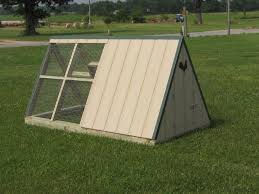A chicken tractor has many advantages. You put it exactly where you'll need it: the garden area or a field where you have harvested, and where the chickens then can scrap, weed and pick insect, hunt and scratch. Or hay (and subsequently grazed) pasture. Or between tall corn. Or in the greenhouse. They help weeding, digging and fighting insects, better than you can yourself.
And they fertilize the land. Fine land diversity or crop rotation.
 It also prevents your chickens are scurrying the same piece of land completely bald and broken. You have to move often enough so that the grass is not greener on the other side. Because otherwise they want to move without being invited. You can avoid this by covering the plot with a net. Set as a support in the middle a long rod with an inverted bottle, otherwise the rod slips through the mesh and sinks too much down.
It also prevents your chickens are scurrying the same piece of land completely bald and broken. You have to move often enough so that the grass is not greener on the other side. Because otherwise they want to move without being invited. You can avoid this by covering the plot with a net. Set as a support in the middle a long rod with an inverted bottle, otherwise the rod slips through the mesh and sinks too much down.
As movable fence you can use a roll of gauze and rebar rods.
But concrete wire mesh I find more convenient. Easy to place. At the corners, I connect them with a pinch clamp to each other, then there are no poles needed. Take pieces no longer than 3 meters, otherwise they swing uncomfortably when carrying them.
You can use a fast (de) mountable loft: you can take 2 plates of 60 cm high and e.g. 150 long as a tent together. A (possibly separately attachable) laying nest at the end, and the first perch low in the middle. Make it with bottom gauze in, then you can move it - locked - with the chickens in. When setting take care that no hen is jammed with her toes under the mesh. Make a portion of the roof hinged (to reach the inside).
Also useful is a cage on wheels. Construct the floor at table height, which is easy to implement, to water (in winter, in the summer outside), to clean and to pick up eggs.
Make the roof hinged.
Make the coop lighter and narrower by hanging a removable nests on the side.
With an bolique shelf stairs the hens can go in and out the coop through the floor or the side.
Make it so narrow that you can also drive in to the greenhouse, shed or barn.
The easiest are quite large wheels, ex. from a (childs) bike. Especially on rough, uneven ground bigger is better and easier.
You can make them removable or retractable, as sometimes is done with a table saw.
Or like a trolley, slightly above the ground. Only when tilting they hit the ground.
A loft that height you should lock in high winds or storms with some tent pegs and a line on the roof!
Larger models of movable pens were also used for the (free range) pigs.
Don’t let wood of base or bottom be in direct contact with the ground, it stays moist and rots quickly. Put a (piece) (concrete) tile or stone under it.
Ducks and geese do not realy need a loft, just a fence and drinking water.
Tourist driver with flattened chicken: “Excuse me, is this chicken yours? "
Farmer: “No, my chickens are not that flat."
